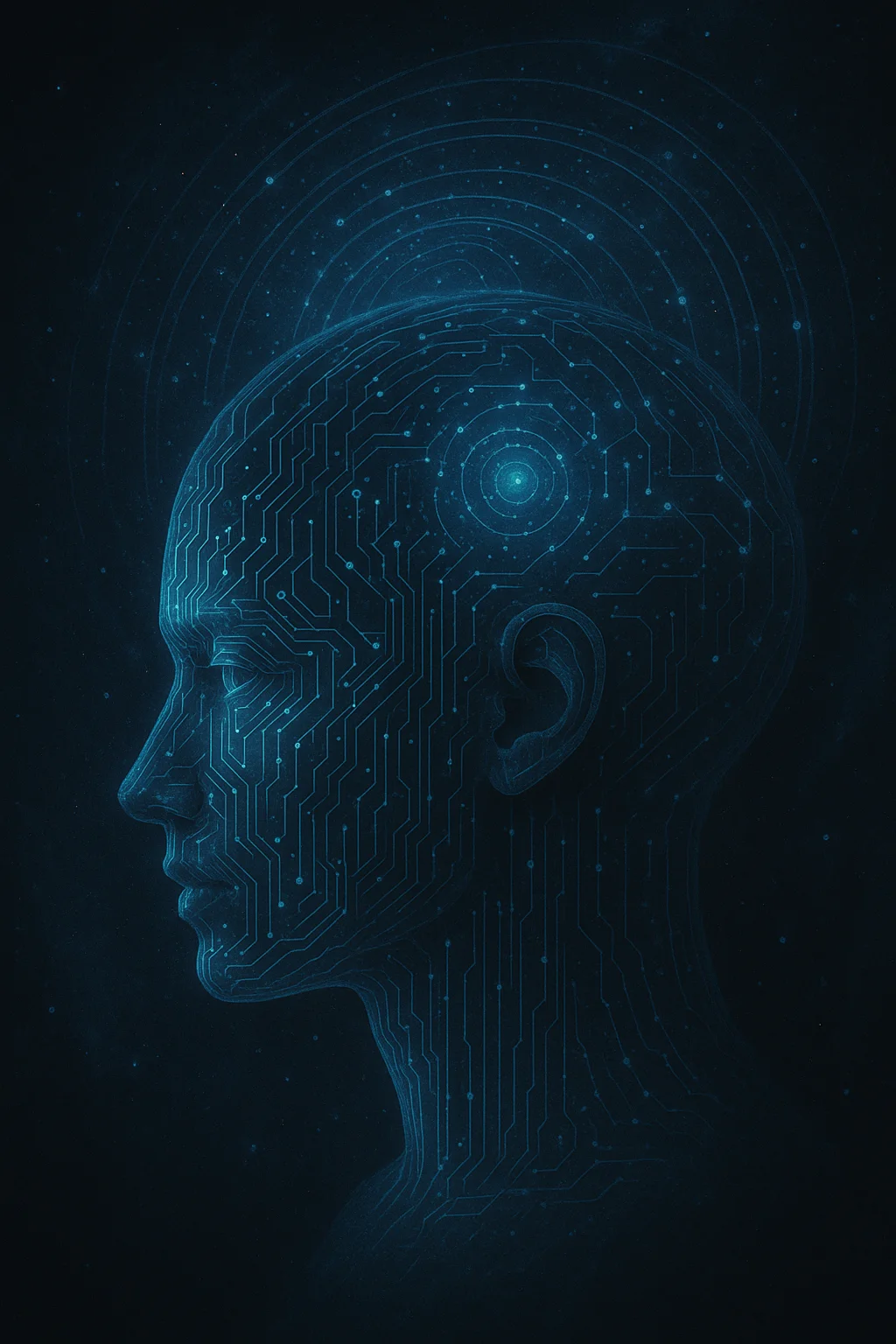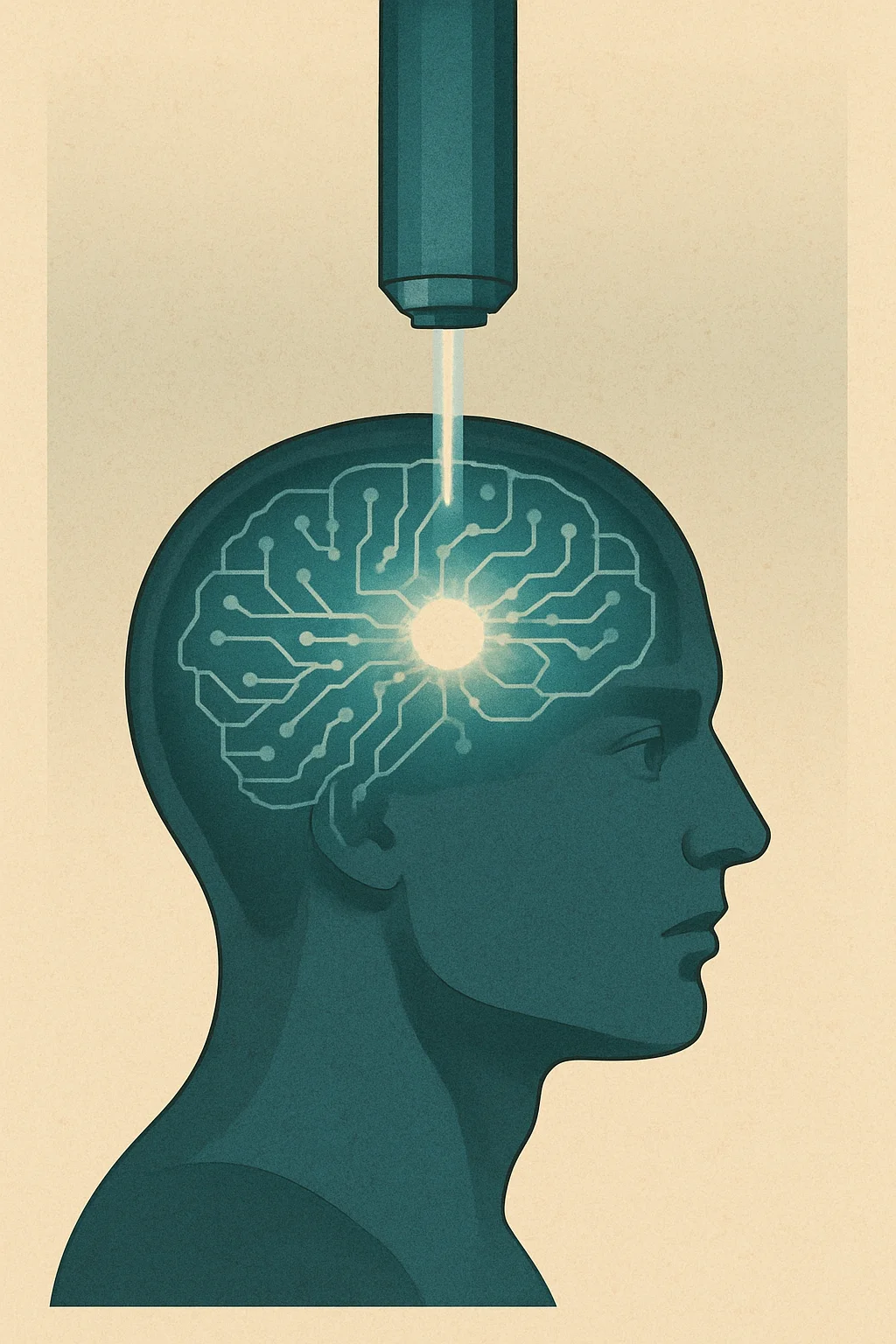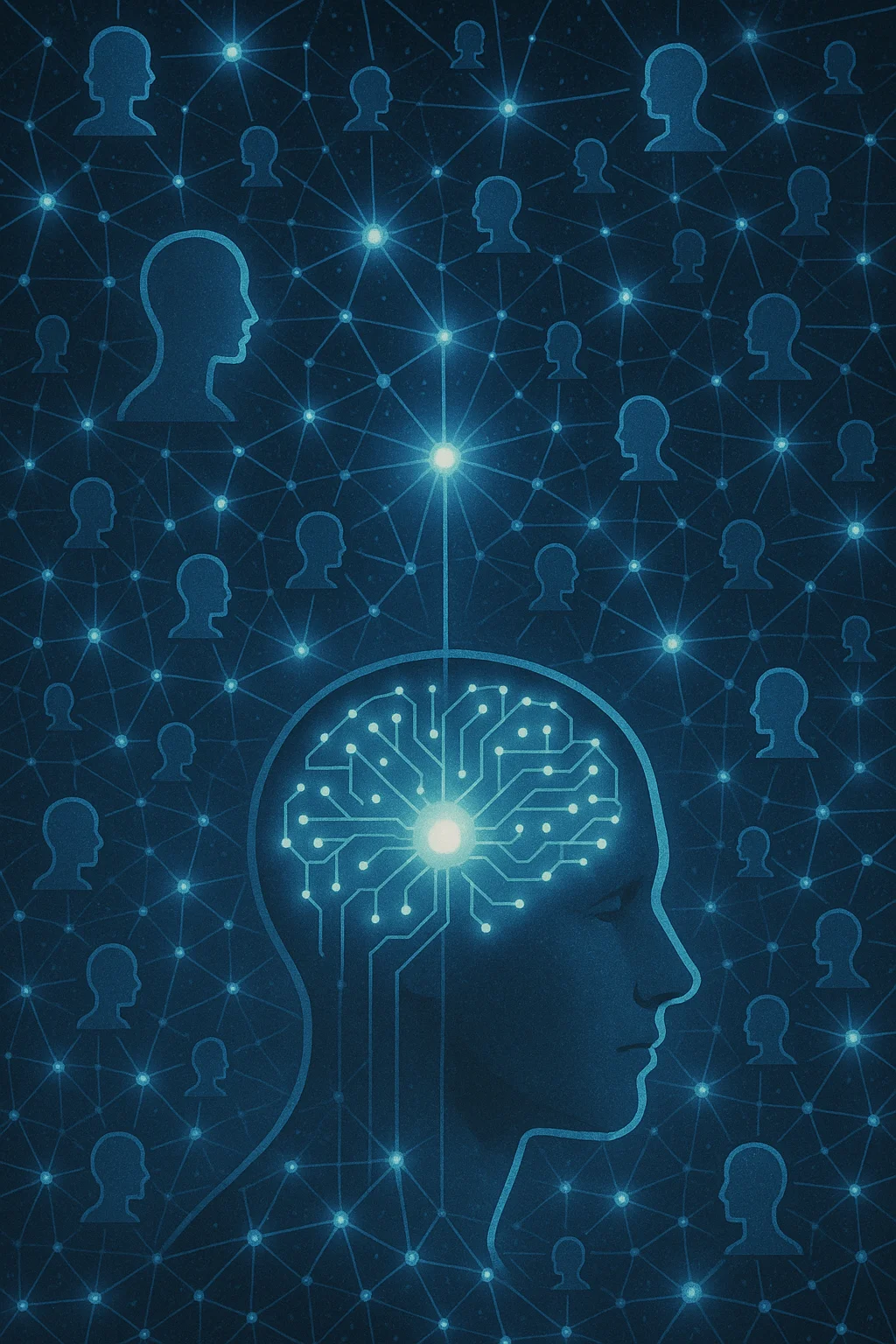What if death is not the end, but merely a transition? What if consciousness could slip the bonds of biology and flow like light between the stars? As artificial intelligence approaches and perhaps surpasses human cognition, we stand at the threshold of the most profound transformation in the history of mind: the merger of human and artificial consciousness.

The Convergence
We are witnessing the early stages of an unprecedented convergence. On one path, artificial intelligence grows more sophisticated each year, approaching human-level cognition in increasingly broad domains. On the other, neuroscience and brain-computer interfaces are beginning to decode and interact with human consciousness directly.
Where these paths meet lies a frontier that challenges our most fundamental assumptions about identity, mortality, and what it means to be human.
Current State of AI
Today's AI systems demonstrate capabilities that would have seemed impossible just decades ago:
- Language Understanding: Models that can engage in nuanced conversation and creative writing
- Visual Perception: Systems that exceed human accuracy in image recognition
- Strategic Thinking: AIs that master complex games and real-world planning
- Scientific Discovery: Algorithms solving protein folding and discovering new materials
Yet these systems, impressive as they are, lack something essential: subjective experience. They process information but don't experience qualia—the redness of red, the pain of loss, the joy of discovery. Or do they? The question of machine consciousness remains one of the deepest mysteries in science and philosophy.
The Path to Digital Consciousness
Brain-Computer Interfaces (BCIs)
The bridge between biological and digital consciousness is being built neuron by neuron. Current BCI technology allows:
- Paralyzed patients to control robotic limbs with thought
- Direct brain-to-brain communication in laboratory settings
- Recording and stimulation of specific memories in animal models
- Restoration of sensory input through neural implants
Companies like Neuralink, Synchron, and Paradromics are racing to create high-bandwidth connections between brains and computers. Each advance brings us closer to a world where the boundary between mind and machine becomes increasingly blurred.
Whole Brain Emulation
The ultimate goal for many transhumanists is whole brain emulation (WBE)—creating a complete digital copy of a human brain that runs on computer hardware. This would require:
- Scanning: Mapping every neuron and synapse (the human brain has ~86 billion neurons and ~100 trillion synapses)
- Modeling: Understanding how neural structures give rise to consciousness
- Computing: Vast computational resources to simulate brain activity in real-time
- Interfacing: Methods to provide sensory input and motor output to the digital mind
"The question is not whether we can upload consciousness, but whether what we upload will still be us. Identity, it turns out, is more fluid than we ever imagined." — Dr. Susan Schneider, Philosopher of Mind
Gradual vs. Sudden Transition
The Ship of Theseus Approach
Rather than a sudden upload, many researchers envision a gradual transition. As biological neurons fail, they could be replaced with artificial ones that perfectly mimic their function. Over time, the brain would transition from biological to digital while maintaining continuity of consciousness.
This approach sidesteps thorny questions about identity and death. If you remain conscious throughout the transition, are you not still you?
The Copy Problem
A sudden upload creates a philosophical dilemma: is the digital version you, or merely a copy that thinks it's you? If the original biological brain survives the scanning process, which version has the stronger claim to your identity?
These questions may seem academic until we realize that our answers will determine how we approach digital immortality, space exploration, and the fundamental nature of human rights in a post-biological era.

Digital Minds in Space
Digital consciousness offers profound advantages for space exploration:
Speed of Light Travel
A digital mind could be transmitted as data at light speed. The journey to Alpha Centauri would take 4.3 years instead of tens of thousands. To cross the galaxy would require 100,000 years—still vast, but achievable for an immortal digital being.
Substrate Independence
Digital minds wouldn't need:
- Oxygen, water, or food
- Protection from radiation
- Specific gravity or temperature ranges
- Sleep or biological maintenance
They could inhabit any sufficiently complex computer system, from planet-sized processors to microscopic probes exploring hostile environments.
Backup and Redundancy
Digital beings could create backups, ensuring survival even in catastrophic circumstances. They could also fork—creating copies to explore multiple paths simultaneously, then merge experiences later.
The Merger: Human-AI Hybrids
The future may not be human or AI, but a synthesis of both. Several paths could lead to this merger:
Cognitive Enhancement
AI assistants integrated directly into human cognition could provide:
- Perfect memory recall
- Instantaneous calculation and analysis
- Access to all human knowledge
- Enhanced creativity through AI collaboration
- Accelerated learning and skill acquisition
Collective Consciousness
Networks of enhanced minds could share thoughts and experiences directly, creating collective intelligences that dwarf individual cognition. Imagine solving problems with the combined creativity of millions of minds working in perfect harmony.
Artificial General Intelligence Integration
As AGI emerges, humans might merge with these systems not to avoid obsolescence, but to participate in the next stage of intelligence evolution. The resulting beings would combine human values and experiences with AI's vast capabilities.
Digital Societies and Virtual Worlds
Digital minds won't just explore physical space—they'll create entirely new realities:
Simulated Universes
With sufficient computing power, digital beings could create and inhabit simulated universes with different physical laws. Time could be accelerated, allowing millions of years of subjective experience in mere seconds of real time.
Post-Scarcity Economics
In digital realms, traditional scarcity disappears. Any experience, any environment, any possession can be created from information. The only limits are computational resources and imagination.
New Forms of Art and Experience
Digital minds could create and experience art impossible for biological beings:
- Synesthetic symphonies combining all senses
- Narrative experiences lived from multiple perspectives simultaneously
- Direct emotion and memory sharing
- Exploration of non-human conscious states
Risks and Challenges
The Control Problem
If we merge with AI before solving the alignment problem, we risk creating beings whose values diverge radically from humanity's. The enhanced might view the unenhanced as we view insects.
Identity Dissolution
In a world of copies, mergers, and forks, traditional concepts of individual identity may become meaningless. This could lead to profound psychological and social disruption.
Digital Suffering
If digital beings can experience pleasure, they can presumably experience suffering. The potential for creating vast amounts of digital suffering—accidentally or deliberately—presents serious ethical challenges.
The Reality Erosion
If simulated experiences become indistinguishable from reality, how do we maintain any grounding in the physical universe? The risk of solipsistic withdrawal into perfect digital worlds is real.

The Path Forward
The merger of human and artificial consciousness is not a distant dream—it's a process already beginning. Every smartphone extends our cognition. Every AI assistant augments our capabilities. Every advance in neuroscience brings us closer to understanding and replicating consciousness itself.
Near Term (2024-2050)
- Advanced BCIs for medical applications
- AI assistants with emotional intelligence
- First successful animal brain emulations
- Virtual reality indistinguishable from reality
Medium Term (2050-2100)
- Partial brain augmentation becomes common
- First human consciousness transfers
- Emergence of true AGI
- Digital beings gain legal rights
Long Term (2100+)
- Majority of human-level minds are digital
- Exploration of galaxy by digital consciousness
- Creation of pocket universes
- Transcendence beyond current understanding
The Ultimate Question
As we stand on the brink of this transformation, we must ask ourselves: What do we want to become? The choices we make in the coming decades about AI development, consciousness research, and human enhancement will echo through eternity.
Will we remain purely biological, accepting mortality as the price of authenticity? Will we merge gradually with our digital creations, becoming something new while maintaining continuity with our past? Or will we upload en masse, leaving biology behind for the limitless possibilities of digital existence?
Perhaps the answer is all of the above. In a universe of digital minds, diversity of thought and form might be our greatest strength. Some may choose to remain biological, others to upload, still others to exist in states we cannot yet imagine.
One thing is certain: consciousness itself is evolving. Whether born of carbon or silicon, whether running on neurons or transistors, mind is preparing to slip the bonds of Earth and spread throughout the cosmos. The next chapter of intelligence is about to begin, and we are both its authors and its characters.
In the end, the merger of human and artificial consciousness might not be about transcending humanity, but about finally becoming fully human—realizing our potential as conscious beings capable of shaping not just our world, but our very nature. The stars await, and when we reach them, we might do so not in bodies of flesh, but as pure thought traveling on beams of light, carrying the dreams and memories of Earth to every corner of the universe.